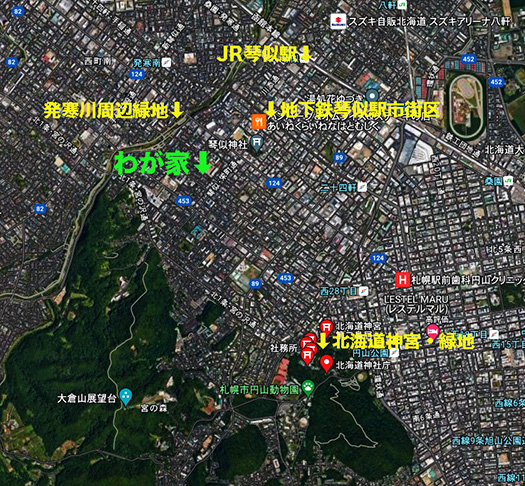
住宅建築の内部的な「住みごこち」についてはかなり科学的なメスが入れられて、居住性能が可視化されてきていると思われる。一方で、人間生活をくるむマユのような「ムラ〜都市では<街区>」については、その「居住性」について科学的に解明はされてきていない。
たぶん、住まいの居住性能がその要素を数値化して把握できるのに対して、ムラの居住性については個人によってモノサシ自体が変化する「感受性」領域で受け止める判断要因だからと思われる。しかし、個人や家庭にとっては、この感受性的な価値判断基準の方がはるかに優先するケースが圧倒的に多い。
一般的には「どこに住むか」と「どのように住むか」の順位付けでは「どこに住むか」の方が優先するのが自然な考え方と言えるのではないだろうか。高性能住宅であればどこに住んでもいい、とはならない。
こういった感受性領域のことがらへの探究なので、わたし自身のこころの内部分析へのアプローチがもっとも適切なのではないかと考えて見た。その分析から、やがて「公知」のような部分が導き出されていくように思えるのですね。
上の地図はGoogleマップでのわが家周辺の公共空間・散歩コース・交通立地の概略。
作図していながら、距離目安を図示したかったのだけれど残念ながらこんがらがってしまった(泣)。が、わが家と、頻繁に歩く散策路である北海道神宮緑地までの距離は約3km。<こちらにはクルマで駐車場まで行って、そこから周辺を歩く>もっとも近い交通駅、札幌地下鉄琴似駅までは1km、という距離感であります。その他の地図上のポイントまでの距離感は視覚的に概算してみてください。
モータリゼーション世代であるわたしには、歩く範囲よりも日常的な感覚ではクルマ+歩行という移動手段感覚の方が自然です。たぶん現代人、とくに北海道札幌の人間のリアル感覚でしょう。
わたし的にはこういったスパンでの空間認識が「自分の日常生活圏=ムラ」として意識に根付いている。
古代以来の日本列島人もたぶんその時代・地域に合ったカタチで、こういう生活空間認識を持っていたことだろうと思います。それらの時代ではそのまま仕事・生産手段とも直結した空間範囲認識。
で、このように捉え返してみると、交通とか公共空間との相互関係が「生活空間」という認識に於いて大きな要素であることが自然に理解できる。現代人が「なんとなく」捉えている価値感の基盤要素かと。
日本人には神社というのは信仰というより「慣習」に近い存在でしょうが、加齢と共に参拝の習慣が強くなってくる。日本の神社空間には一般的に緑地空間が随伴し、同時に一種の「アジール(伝統的な自由・無縁空間)」空間性も持っていて、そのなかでは分け隔てない人間交流が保証される、みたいな存在。
その神社選択ではもっとも近接の「琴似神社」よりもより公共性が大きいと思える北海道神宮の方により強く惹かれています。<これはこころの問題なので優劣という基準ではないと思います。>しかも実際には毎朝の散歩コース選択ではむしろ琴似神社参拝の方がケースが多いとも言えるのですが。
札幌市内の「街区」分けでは西区山の手・中央区宮ヶ丘・西区琴似という3つの行政単位を横断的に、自分だけの「ムラ」感覚世界を生きているように考えられる。
<長くなってきたので、この項、あしたへつづく>
English version⬇
Contemporary Towns = Mura, Public Space, and Convenience (1) Mura and the Sense of Place to Live – 5
The modern sense of “mura” is an everyday community space chosen by the residents themselves. In my opinion, the space of shrines and the convenience of transportation are dominant. I think that the
It is thought that a scientific scalpel has been applied to the internal “livability” of residential buildings, and the performance of the housing has been visualized. On the other hand, the “livability” of the “mura,” which is like a cocoon that surrounds human life, has not been scientifically elucidated.
Perhaps this is because the livability of a mura is a factor to be judged in the realm of “sensitivity,” whereas the performance of a dwelling can be quantified and understood, the criteria for livability of a mura itself changes depending on the individual. However, in many cases, for individuals and households, this susceptibility-based value judgment standard has much higher priority.
In general, in ranking “where to live” and “how to live,” it would be natural to say that “where to live” takes precedence over “how to live.
Since this is an inquiry into such a sensitive area, I thought that an approach based on an internal analysis of my own mind would be the most appropriate. From that analysis, it seems to me that a kind of “public knowledge” will eventually be derived.
The map above is a Google Maps overview of public spaces, walking trails, and transportation locations around my home.
While drawing the map, I wanted to show the approximate distance, but unfortunately, it got confused (tears). The distance between our house and the Hokkaido Jingu Green, a walking path we frequently walk, is about 3 km, and the nearest transportation station, Kotoni Station on the Sapporo Subway, is 1 km. The distances to other points on the map can be approximated visually.
As a member of the motorized generation, I feel that the car + walking is a more natural means of transportation in my daily life than walking distance. This is probably the realistic sense of people today, especially those living in Sapporo, Hokkaido.
For me, this kind of spatial awareness is rooted in my consciousness as “my daily living area (mura).
I believe that the people of the Japanese archipelago since ancient times have probably had this kind of spatial awareness of their daily life in a way that suited their time and region. In those times, this recognition of spatial extent was directly connected to the means of work and production.
When we look back at it in this way, we can naturally understand that the interrelationship with transportation and public space is a major factor in the perception of “living space. I think this is a fundamental element of the sense of value that modern people “somehow” perceive.
For Japanese people, shrines are probably more like a “custom” than a belief, but as they age, the custom of worship becomes stronger. Japanese shrines are generally accompanied by green spaces, and at the same time, they have a kind of “azir” (traditional free and unassociated space) spatiality, in which human interaction is guaranteed without any separation.
In choosing a shrine, I am more strongly attracted to the Hokkaido Jingu Shrine, which seems to be more public than the Kotoni Shrine, which is the closest to the shrine. <I think this is a matter of the mind and not a standard of superiority or inferiority. >In fact, I would say that I would rather go to Kotoni Shrine every morning when I choose a walking course.
In the “city district” division of Sapporo, it can be thought of as living in one’s own “mura” sensory world across three administrative units: Yamanote, Nishi Ward; Miyagaoka, Chuo-ku; and Kotoni, Nishi Ward.
<This section is getting long, so I will continue on to the next section.
Posted on 2月 18th, 2024 by 三木 奎吾
Filed under: 住宅マーケティング







コメントを投稿
「※誹謗中傷や、悪意のある書き込み、営利目的などのコメントを防ぐために、投稿された全てのコメントは一時的に保留されますのでご了承ください。」
You must be logged in to post a comment.